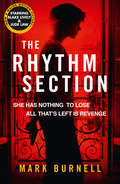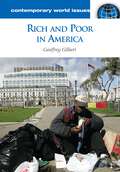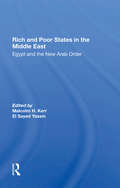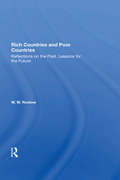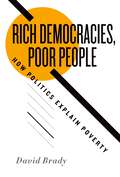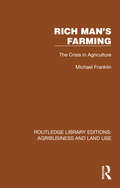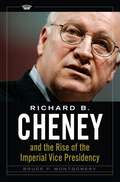- Table View
- List View
The Rhythm Section: A Stephanie Patrick Thriller (Stephanie Patrick Thrillers Ser. #1)
by Mark BurnellSoon to be a major motion picture, from the producers of the James Bond film series, starring Jude Law and Blake Lively. She has nothing to lose and only revenge to live for
Rhythms of Resistance: African Musical Heritage in Brazil
by Peter FryerAfrican rhythms are at the heart of contemporary black Brazilian music. Surveying a musical legacy that encompasses over 400 years, Rhythms of Resistance traces the development of this rich cultural heritage. *BR**BR*Acclaimed author Peter Fryer describes how slaves, mariners and merchants brought African music from Angola and the ports of East Africa to Latin America. In particular, they brought it to Brazil – today the country with the largest black population of any outside Africa. Fryer examines how the rhythms and beats of Africa were combined with European popular music to create a unique sound and dance tradition. Fryer focuses on the political nature of this musical crossover and the role of an African heritage in the cultural identity of Brazilian blacks today.*BR**BR*Rhythms of Resistance is an absorbing account of a theme in global music and is rich in fascinating historical detail.
Rice and Agricultural Policies in Japan: The Loss of a Traditional Lifestyle
by Nicole L. FreinerThis book chronicles Japan’s rice farmers who live in mainly rural areas in the west and south of Japan through original interviews conducted in Japanese. It argues that current agricultural policy as well as the tightening relationship between the US and Japan is a death sentence for a traditional lifestyle that is vital to Japan’s notion of national identity. The project covers recent agricultural policies, including the Trans-Pacific Partnership (TPP) agreement and its potential consequences on Japan’s food sovereignty and documents the effect of these policies on rice farmers. This volume is ideal for those interested in Japan’s agricultural policies and rural and traditional Japanese lifestyle.
Rice Production Structure and Policy Effects in Japan: Quantitative Investigations
by Yoshimi KurodaKuroda uses quantitative measures to investigate the rice production structure and effects of agricultural policies in Japan over the second half of the 20th century. Almost all policies have played negative roles in transferring paddy lands from small- to large-scale farms, which has slowed down to modernize the rice sector.
Rich and Poor in America: A Reference Handbook (Contemporary World Issues)
by Geoffrey GilbertThis work provides a thorough overview and analysis of the increasing gap between the Americans at the top and bottom of the economic scale.Rich and Poor in America: A Reference Handbook provides an in-depth analysis of—and possible solutions for—the growing disparity between those at the top of the economic ladder and everyone else, a disparity that has reached its highest level since the 1920s. Expertly researched and written, Rich and Poor in America explores a wide range of explanations for the trend that undercuts the U.S.'s "Land of Opportunity" image, including heavy immigration, weakening labor unions, globalization, and technological change. Separate chapters look at the issue chronologically and from a global perspective, while biographical sketches provide fascinating portraits of some of the "winners" in our winner-take-all society, as well as leading scholars and activists working on this issue. copywriter rewrite:Rich and Poor in America: A Reference Handbook provides an in-depth analysis of the widening income gap in the United States—a situation where, over nearly three decades, fewer and fewer Americans have made significant financial strides while more and more have seen their real incomes remain the same or decrease. Objective, expertly researched and clearly written, Rich and Poor in America looks at a wide range of explanations for the income gap, including heavy immigration, weakening labor unions, globalization, and technological change. Separate chapters examine the trend as it has evolved over time and from a global perspective, while biographical sketches provide fascinating portraits of some of notable successful individuals as well as leading scholars and activists working on this issue.
Rich And Poor States In The Middle East: Egypt And The New Arab Order
by Malcolm H. Kerr El Sayed Yassin Jeswald Salacuse Ismail SerageldinWhile oil wealth has enriched some Middle East Arab nations, others that lack oil resources have remained poor and are looking now to their oil-rich neighbors for development assistance. This collection of studies on the economic, social, and political relationships between the haves and the have-nots in the Middle East focuses on Egypt-the largest state in the region-and on its prospects for change based on financial assistance from other Arab countries.The authors have many disagreements about the future of both rich and poor nations in the Middle East and considerable skepticism about the possibility of transforming Egypt, but they do agree that the future must be projected in the framework of a new regional order in which oil wealth, labor migration, and liberalized national economies are fundamental realities.
Rich And Poor States In The Middle East: Egypt And The New Arab Order
by Malcolm H. Kerr El Sayed Yassin Jeswald Salacuse Ismail SerageldinWhile oil wealth has enriched some Middle East Arab nations, others that lack oil resources have remained poor and are looking now to their oil-rich neighbors for development assistance. This collection of studies on the economic, social, and political relationships between the haves and the have-nots in the Middle East focuses on Egypt-the largest state in the region-and on its prospects for change based on financial assistance from other Arab countries.The authors have many disagreements about the future of both rich and poor nations in the Middle East and considerable skepticism about the possibility of transforming Egypt, but they do agree that the future must be projected in the framework of a new regional order in which oil wealth, labor migration, and liberalized national economies are fundamental realities.
Rich Countries And Poor Countries: Reflections On The Past, Lessons For The Future
by W. W. Rostow W W RostowIn these ten graceful and learned essays, Professor Rostow addresses the future of the world and its economy from the perspective of his more than forty years of study and reflection on the problems of economic development. Rostow focuses on how we are to create and sustain a civilized and industrious world society in an international trading system beset by historic trends with enormous potential for disruption. These powerful forces—including an industrial revolution of microelectronics, genetic engineering, robots and lasers, and the diffusion of high technology to low-wage areas—are creating different sets of irrevocably intertwined problems for nations around the world. The issues are illuminated here by Rostow’s mastery of economic history as well as the history of political economy. In addition to general discussions placing the issues historically and intellectually, there are essays highlighting the particular concerns of Mexico, India, Japan, and the Pacific Basin. In his final remarks, Rostow speculates on how the large economic trends affecting the superpowers may lead gradually to a truly significant lessening of East-West tensions. This book will be valuable for any citizen or student concerned about the future of the global economy.
Rich Countries And Poor Countries: Reflections On The Past, Lessons For The Future
by W. W. Rostow W W RostowIn these ten graceful and learned essays, Professor Rostow addresses the future of the world and its economy from the perspective of his more than forty years of study and reflection on the problems of economic development. Rostow focuses on how we are to create and sustain a civilized and industrious world society in an international trading system beset by historic trends with enormous potential for disruption. These powerful forces—including an industrial revolution of microelectronics, genetic engineering, robots and lasers, and the diffusion of high technology to low-wage areas—are creating different sets of irrevocably intertwined problems for nations around the world. The issues are illuminated here by Rostow’s mastery of economic history as well as the history of political economy. In addition to general discussions placing the issues historically and intellectually, there are essays highlighting the particular concerns of Mexico, India, Japan, and the Pacific Basin. In his final remarks, Rostow speculates on how the large economic trends affecting the superpowers may lead gradually to a truly significant lessening of East-West tensions. This book will be valuable for any citizen or student concerned about the future of the global economy.
Rich Democracies, Poor People: How Politics Explain Poverty
by David BradyPoverty is not simply the result of an individual's characteristics, behaviors or abilities. Rather, as David Brady demonstrates, poverty is the result of politics. In Rich Democracies, Poor People, Brady investigates why poverty is so entrenched in some affluent democracies whereas it is a solvable problem in others. Drawing on over thirty years of data from eighteen countries, Brady argues that cross-national and historical variations in poverty are principally driven by differences in the generosity of the welfare state. An explicit challenge to mainstream views of poverty as an inescapable outcome of individual failings or a society's labor markets and demography, this book offers institutionalized power relations theory as an alternative explanation.
Rich Democracies, Poor People: How Politics Explain Poverty
by David BradyPoverty is not simply the result of an individual's characteristics, behaviors or abilities. Rather, as David Brady demonstrates, poverty is the result of politics. In Rich Democracies, Poor People, Brady investigates why poverty is so entrenched in some affluent democracies whereas it is a solvable problem in others. Drawing on over thirty years of data from eighteen countries, Brady argues that cross-national and historical variations in poverty are principally driven by differences in the generosity of the welfare state. An explicit challenge to mainstream views of poverty as an inescapable outcome of individual failings or a society's labor markets and demography, this book offers institutionalized power relations theory as an alternative explanation.
The Rich Girls' Club
by HoneyBWhen money isn't enough for Brooks Kennedy, Morgan Childs, Storm Dangerfield, and Hope Andrews, the women decide to take over the governor's house in...THE RICH GIRLS' CLUBCalifornia has never had a female governor and Morgan Childs is determined to change that with the help of her friends. Gathering the backing of the wealthiest women in California, she convinces her best friend, Brooks Kennedy, to run for governor.Morgan's campaign strategy is nontraditional, but she knows her plan to sexually blackmail each of Brooks's opponents is virtually foolproof. Once she convinces the team of her tactics, they do whatever it takes to get incriminating evidence on Brooks's opponents.One by one each candidate is forced to withdraw from the governor's race, and Morgan couldn't be happier, until someone attempts to kill Brooks. With so many enemies, Brooks has no idea who wants her dead.When a secret is revealed, Morgan feels betrayed and will stop at nothing to get revenge. Now, Brooks doesn't know who to trust and the women stand to lose more than they bargained for.
Rich Man's Farming: The Crisis in Agriculture (Routledge Library Editions: Agribusiness and Land Use #10)
by Michael FranklinOriginally published in 1988, this book was written at a time of excessive budgetary costs, huge surpluses and damaging trade conflicts. This study examines why a crisis situation was allowed to develop, nd proposes the most effective ways, both nationally and internationally – to chieve more rational agricultural support and trade policies. It concentrates on the efforts to reform the Common Agricultural Policy in the EU, on United States support policies, and on the GATT negotiations.
Rich Man's Farming: The Crisis in Agriculture (Routledge Library Editions: Agribusiness and Land Use #10)
by Michael FranklinOriginally published in 1988, this book was written at a time of excessive budgetary costs, huge surpluses and damaging trade conflicts. This study examines why a crisis situation was allowed to develop, nd proposes the most effective ways, both nationally and internationally – to chieve more rational agricultural support and trade policies. It concentrates on the efforts to reform the Common Agricultural Policy in the EU, on United States support policies, and on the GATT negotiations.
Rich Pictures: Encouraging Resilient Communities (Earthscan Tools for Community Planning)
by Stephen Morse Simon Bell Tessa BergRich Pictures focuses on the value of developing visual narratives – Rich Pictures – as an important component and starting point for community participation. A key device for the community to share ideas and perspectives on current and potential future situations, Rich Pictures provide a shared space for members to set out ideas and negotiate. While Rich Pictures are widely and globally used, this is the first book discussing their use, and how and when to use this technique for maximum participatory value. A valuable read for community engagement professionals, planners, politicians, and members of affected communities, Rich Pictures is richly illustrated with examples and authors’ testimonials.
Rich Pictures: Encouraging Resilient Communities (Earthscan Tools for Community Planning)
by Stephen Morse Simon Bell Tessa BergRich Pictures focuses on the value of developing visual narratives – Rich Pictures – as an important component and starting point for community participation. A key device for the community to share ideas and perspectives on current and potential future situations, Rich Pictures provide a shared space for members to set out ideas and negotiate. While Rich Pictures are widely and globally used, this is the first book discussing their use, and how and when to use this technique for maximum participatory value. A valuable read for community engagement professionals, planners, politicians, and members of affected communities, Rich Pictures is richly illustrated with examples and authors’ testimonials.
Rich Russians: From Oligarchs to Bourgeoisie
by Elisabeth SchimpfösslThe lives of wealthy people have long held an allure to many, but the lives of wealthy Russians pose a particular fascination. Having achieved their riches over the course of a single generation, the top 0.1 percent of Russian society have become known for ostentatious lifestyles and tastes. Nevertheless, as Elisabeth Schimpfössl shows in this book, their stories reveal a bourgeois existence that is distinct in its circumstances and self-definition, and far more complex than the caricatures suggest. Rich Russians takes a deep and unprecedented look at this group: their personal stories, trajectories, ideas about life and how they see their role and position both on top of Russian society as well as globally. These people grew up and lived through a historically unique period of economic turmoil and social change following the collapse of the Soviet Union. But when taken in a wider historical context, their lives follow a familiar path, from new money to respectable money; parvenus becoming part of Society. Based on interviews with millionaires, billionaires, their spouses and children, Rich Russians concludes that, as a class, they have acquired all sorts of cultural and social resources which help consolidate their personal power. They have developed distinguished and refined tastes, rediscovered their family history, and begun actively engaging in philanthropy. Most importantly, they have worked out a narrative to justify why they deserve their elitist position in society - because of who they are and their superior qualities - and why they should be treated as equals by the West. This is a group whose social, cultural and political influence is likely to outlast any regime change. As the first book to examine the transformation of Russia's former "robber barons" into a new social class, Rich Russians provides insight into how this nation's newly wealthy tick.
Rich Russians: From Oligarchs to Bourgeoisie
by Elisabeth SchimpfösslThe lives of wealthy people have long held an allure to many, but the lives of wealthy Russians pose a particular fascination. Having achieved their riches over the course of a single generation, the top 0.1 percent of Russian society have become known for ostentatious lifestyles and tastes. Nevertheless, as Elisabeth Schimpfössl shows in this book, their stories reveal a bourgeois existence that is distinct in its circumstances and self-definition, and far more complex than the caricatures suggest. Rich Russians takes a deep and unprecedented look at this group: their personal stories, trajectories, ideas about life and how they see their role and position both on top of Russian society as well as globally. These people grew up and lived through a historically unique period of economic turmoil and social change following the collapse of the Soviet Union. But when taken in a wider historical context, their lives follow a familiar path, from new money to respectable money; parvenus becoming part of Society. Based on interviews with millionaires, billionaires, their spouses and children, Rich Russians concludes that, as a class, they have acquired all sorts of cultural and social resources which help consolidate their personal power. They have developed distinguished and refined tastes, rediscovered their family history, and begun actively engaging in philanthropy. Most importantly, they have worked out a narrative to justify why they deserve their elitist position in society - because of who they are and their superior qualities - and why they should be treated as equals by the West. This is a group whose social, cultural and political influence is likely to outlast any regime change. As the first book to examine the transformation of Russia's former "robber barons" into a new social class, Rich Russians provides insight into how this nation's newly wealthy tick.
The Rich, The Poor, And The Taxes They Pay
by Joseph A. PechmanThis book presents a selection of essays on public finance, which is concerned with taxation, income maintenance, and social security, with emphasis on the analysis of policy alternatives to improve tax and transfer systems. It is useful for those who are interested in learning tax policy issues.
The Rich, The Poor, And The Taxes They Pay
by Joseph A. PechmanThis book presents a selection of essays on public finance, which is concerned with taxation, income maintenance, and social security, with emphasis on the analysis of policy alternatives to improve tax and transfer systems. It is useful for those who are interested in learning tax policy issues.
Rich Voter, Poor Voter, Red Voter, Blue Voter: Social Class and Voting Behavior in Contemporary America
by Charles PrysbyThis book examines the changing relationship between social class and voting behavior in contemporary America. At the end of the 20th century, working-class white voters were significantly more Democratic than their middle-class counterparts, as they had been since the 1930s. By the second decade of the 21st century, that long-standing relationship had reversed: Republicans now do better among working-class whites. While Trump accentuated this trend, the change began before 2016, something that has not been fully appreciated or understood. Charles Prysby analyzes this development in American politics in a way that is understandable to a wide audience, not just scholars in this field. Drawing on a wealth of survey data, this study describes and explains the underlying causes of the change that has taken place over the past two decades, identifying how social class is directly related to partisan choice. Attitudes on race and immigration, on social and moral issues, and on economic and social welfare policies are all part of the explanation of this 21st century development in American political trends. Rich Voter, Poor Voter, Red Voter, Blue Voter: Social Class and Voting Behavior in Contemporary America is essential reading for scholars, students, and all others with an interest in American elections and voting behavior.
Rich Voter, Poor Voter, Red Voter, Blue Voter: Social Class and Voting Behavior in Contemporary America
by Charles PrysbyThis book examines the changing relationship between social class and voting behavior in contemporary America. At the end of the 20th century, working-class white voters were significantly more Democratic than their middle-class counterparts, as they had been since the 1930s. By the second decade of the 21st century, that long-standing relationship had reversed: Republicans now do better among working-class whites. While Trump accentuated this trend, the change began before 2016, something that has not been fully appreciated or understood. Charles Prysby analyzes this development in American politics in a way that is understandable to a wide audience, not just scholars in this field. Drawing on a wealth of survey data, this study describes and explains the underlying causes of the change that has taken place over the past two decades, identifying how social class is directly related to partisan choice. Attitudes on race and immigration, on social and moral issues, and on economic and social welfare policies are all part of the explanation of this 21st century development in American political trends. Rich Voter, Poor Voter, Red Voter, Blue Voter: Social Class and Voting Behavior in Contemporary America is essential reading for scholars, students, and all others with an interest in American elections and voting behavior.
Richard B. Cheney and the Rise of the Imperial Vice Presidency
by Bruce P. MontgomeryOn taking office in 2001, Dick Cheney crowned himself the first imperial vice president in the nation's history, transforming a traditionally inconsequential office into a de facto fourth branch of government. Taking a less journalistic and personal approach to Cheney than previous biographers, this critical new biography shows exactly how Cheney engineered his arrogation of vast executive powers—and the dire consequences his power grab has had and will long continue to have for the office of the vice presidency, the balance of powers, the Constitution, geopolitics, and America's security, strength, and prestige.Taking advantage of the administration's global war on terrorism, a president inexperienced in matters of war and peace, and a Republican Congress that rated party power above institutional prerogatives, Vice President Cheney moved with astonishing speed and energy to assume a dominant role on the national and international stage as the effective president-in-proxy of the United States. Cheney asserted that all constitutional checks and balances and all individual liberties under the Bill of Rights are subservient to the president's powers as commander-in-chief in confronting international terrorism. Although former administrations had made power grabs in the past in times of national crisis, no president-and certainly no vice president-has ever exerted such sweeping claims of executive power on so many fronts in violation of the bedrock principles of the Constitution.
Richard B. Cheney and the Rise of the Imperial Vice Presidency
by Bruce P. MontgomeryOn taking office in 2001, Dick Cheney crowned himself the first imperial vice president in the nation's history, transforming a traditionally inconsequential office into a de facto fourth branch of government. Taking a less journalistic and personal approach to Cheney than previous biographers, this critical new biography shows exactly how Cheney engineered his arrogation of vast executive powers—and the dire consequences his power grab has had and will long continue to have for the office of the vice presidency, the balance of powers, the Constitution, geopolitics, and America's security, strength, and prestige.Taking advantage of the administration's global war on terrorism, a president inexperienced in matters of war and peace, and a Republican Congress that rated party power above institutional prerogatives, Vice President Cheney moved with astonishing speed and energy to assume a dominant role on the national and international stage as the effective president-in-proxy of the United States. Cheney asserted that all constitutional checks and balances and all individual liberties under the Bill of Rights are subservient to the president's powers as commander-in-chief in confronting international terrorism. Although former administrations had made power grabs in the past in times of national crisis, no president-and certainly no vice president-has ever exerted such sweeping claims of executive power on so many fronts in violation of the bedrock principles of the Constitution.
